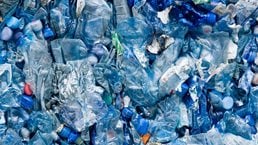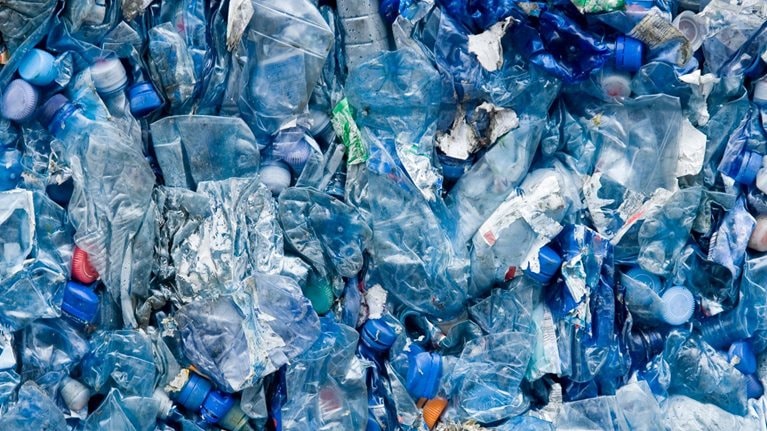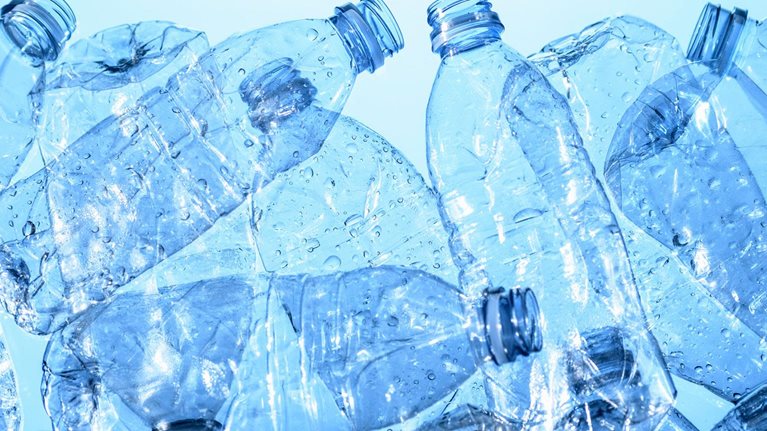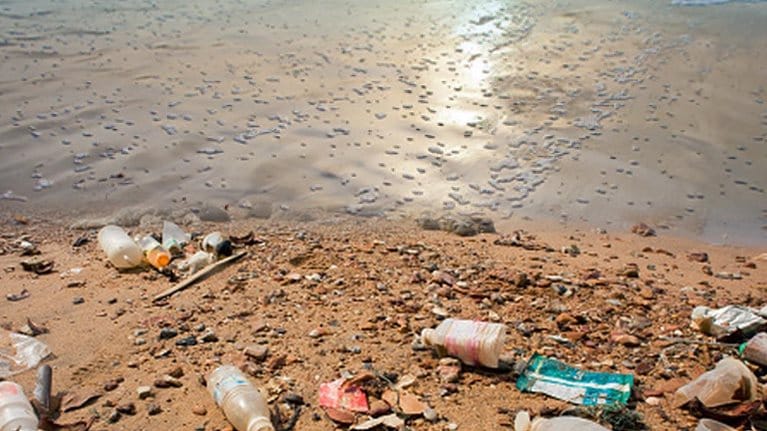Plastic has become ubiquitous in modern life. It keeps our food from spoiling, helps us transport goods with less energy and less breakage than other materials, makes our vehicles lighter and more energy efficient, and is inexpensive, durable, and easily formed. However, its attractive performance and low cost have enabled broad adoption, creating a fundamental challenge with the growth in plastic waste—including in packaging and single-use food-service waste. Over the past two years, societal pressure around plastic waste has grown considerably, mainly driven by the highly visible impact on marine environments and a broader awareness of sustainable lifestyles. Studies show that plastic pollution in the world’s oceans is largely the result of unmanaged waste in developing economies in Asia.1 In the United States, waste is generally managed2 and leakage to marine environments is low—but recovery rates for packaging and food-service plastic are about 28 percent (split between mechanical recycling and waste-to-energy), compared with 90 percent in other leading industrialized countries, such as Germany and Japan.3
Recycling is the major lever for addressing the plastic waste challenge. While “reducing” and “reusing” can have some impact, in most realistic scenarios there are large volumes of plastic waste that only increased recycling can handle. Further, there is a meaningful business opportunity associated with recycling—recovery of US plastic packaging and food-service plastic alone could represent a pool of earnings before interest, tax, depreciation, and amortization (EBITDA) of $2 billion to $4 billion per year. However, increasing recycling in the United States will not be easy. Our research shows that a robust system for plastic-waste recycling in the United States requires solving challenges related to consumer behavior, access to recycling, collection and sortation methods, recovery capabilities (including mechanical and advanced recycling4), and economics and end markets (see sidebar “About the research”). Further complicating matters, the root causes of (and solutions to) these challenges are interdependent—as supply solutions bring more plastics into the recycling system, it will be crucial to increase demand for recycled materials. Critically, we see a need for collaboration and commitment across the value chain before solutions can be implemented at scale.
Demand for plastics is large and growing—and so is plastic waste
In the United States, approximately 37 million tons of plastic are used every year. Of this, packaging and food-service plastics represent about 16 million tons, and these are typically “single use.” On average, Americans consume 100 pounds per person, per year, of packaging and food-service plastics.
The main resin types5 found in these packaging and food-service applications are PET (polyethylene terephthalate, used in soft-drink bottles), HDPE (high-density polyethylene, used in milk jugs), LDPE (low-density polyethylene, used in films and wraps), and PP (polypropylene, used in yogurt containers and bottle caps). Together, these polymer types make up approximately 85 percent of single-use volume (Exhibit 1). The remaining two major resin types, PVC (polyvinyl chloride, used in blister packs) and PS (polystyrene, used in food service, such as cups), each represent less than 10 percent of the volume.

Only approximately 12 percent of this material is recycled (see sidebar “Primer on plastics recycling”). Another 16 percent is combusted with municipal trash, from which the heat value is recovered, but the majority—more than 70 percent, or 11 million tons—is sent to landfill. Texas and California account for approximately 25 percent of unrecovered volumes, reflecting about 20 percent of the US population, below-average use of waste-to-energy and (for Texas) a lower recycling rate.
As plastic consumption grows, the volume of unrecovered plastic will continue to grow as well. Recycling volumes in the United States were essentially flat from 2010 to 2017, despite growing consumption. Conducting business as usual could mean that demand for plastic in packaging and food service could reach 20 million to 22 million tons by 2040 (35 percent above current levels). Maintaining even currently low recycling rates will require meaningful investment, and some recent developments (such as limitations on waste exports) may have even reduced US recycling rates. Improving recovery, however, will require more than incremental change—it demands a major rethinking of the current way of working.
Challenges to address
We see six challenges that will need to be addressed to improve plastic recycling in the United States (Exhibit 2). These include two challenges for the supply of plastic waste (consumer behavior and access to recycling), three for the demand (collection and sortation, recovery technologies, and economics and end markets), and value-chain coordination.

Supply challenges
Consumer behavior. Even when consumers have convenient access to recycling, such as curbside service, they often fail to put plastic into the recycling bin. In fact, consumers with access to curbside recycling only place about 40 percent of recyclables into the recycling bin. The remaining 60 percent of material goes directly to landfill or is incinerated—and is therefore no longer able to be recycled.
Consumers cite confusion and apathy as primary reasons for poor recycling behavior. Confusion arises from a lack of consistency in recycling programs and the wide range of materials that consumers handle. It might be unclear what should be placed in each bin—for example, bottles can be recycled but pouches cannot; tubs can be recycled but bags and tubes cannot. Guidelines vary from municipality to municipality, and recyclability is typically not indicated on packaging. Numeric resin codes that identify polymer types, such as the number one on the bottom of PET bottles, do little to communicate what should be done with the material once it becomes waste. Moreover, consumers see little impact from their behavior: whether plastic waste goes into the recycling bin or the trash bin might not make any economic difference to them.
However, consumer behavior can be influenced through education, labeling, incentives, and enforcement. Top-performing cities, such as Austin, Phoenix, and Seattle, achieve recycling rates 10 to 20 times higher than lagging cities, such as Charlotte, Chicago, and Houston. One reason for the higher recycling rates in top-performing cities could be that they employ pay-as-you-throw incentive programs, in which citizens are charged fees for landfill waste streams, such as trash, but are not charged for recycling streams. High-performing cities also invest in education on recycling for residents—including efforts to drive messaging in schools, such as in Portland, Oregon. There is also a need for clear labeling and associated consistency and harmonization in recycling rules across programs.
Would you like to learn more about our Chemicals Practice?
Changing consumer behavior is possible. Successful examples in the United States include energy-efficiency programs—energy intensity (defined as BTU per dollar GDP) fell from 12,000 in 1980 to 6,000 in 20146—and seat-belt usage, for which rates increased from 14 percent in 1983 to 90 percent in 2017.7
Access to recycling. The underlying drivers of recycling access are economic and regulatory. Approximately 30 million rural US households and 15 million suburban US households lack curbside recycling—reflecting the distance between homes, the cost of using trucks to pick up recyclables, and the willingness of municipalities to invest in recycling programs.
Closing the access gap will require significant infrastructure build-out alongside appropriate considerations of how to make recycling cost effective for residents. Many multifamily residences in the United States—approximately eight million of which lack curbside recycling—fall under commercial rules, meaning recycling services are not provided by the municipality and landlords are responsible for providing and paying for services. Therefore, closing the gap may require consideration of incentives and the regulatory environment.
Demand challenges
Collection and sortation. Current sorting technology is not effective at handling approximately 30 percent of plastic packaging. For example, problems occur with flat items, such as film, bags, lids, and pouches, as well as small items, such as toiletry tubes. Material recovery facilities (MRFs) use ballistic sorters to separate flat materials, and these flat plastic forms often end up in paper bales or tangled in the sorters. Small items—typically less than two inches in width—fall through screens and end up with the MRF residual waste, which is sent to landfill. As a result, these materials are typically not accepted in recycling programs (see sidebar “Recyclability and product redesign”).
There are programs underway to collect and sort flat items, including enhanced sortation (upgrading of MRFs), secondary bag programs that collect specific plastics, front-of-store collection, and multi-stream collection. These approaches offer various trade-offs on efficacy, cost, and consumer participation requirements (Exhibit 3). As packaging shifts from traditional rigid forms to flexible material (for example, from laundry detergent bottles to flex pouches), more plastic will face these collection and sortation challenges.
Recovery technologies. Mechanical reclaiming—conversion of waste polymer back into usable polymer through heating and extrusion—is effective for waste that is currently sorted by MRFs but will face limitations as the collection rate increases. Mechanical recycling affects the consistency, color, and properties of plastic, and becomes a greater challenge when the material is recycled multiple times. Estimates vary for the upper limit on mechanical recycling system-wide—Germany and Japan have demonstrated mechanical recycling rates of up to 20 to 40 percent. Achieving recovery rates above this level may require further recovery methods.
Waste-to-energy, a process in which trash and recyclables are combusted with heat recovery, has been widely adopted in other countries (for example, Germany and Japan) but faces challenges in the United States due to low landfill costs (due to relatively high land availability), low energy prices (due to low natural gas prices), and public opinion. There are also concerns about emissions associated with this process. Countries that have achieved near-total diversion of plastic from landfill send significant quantities of plastic waste to be combusted with heat recovery.
Advanced recycling may be an attractive alternative. There are three types of advanced recycling.
- Conversion—plastic is converted to liquid hydrocarbons to be used for fuels or as feedstock for “new” plastic.
- Decomposition—polymers are transformed back into monomers (for example, polystyrene becomes styrene).
- Purification—polymers are dissolved in solvents, and the desired polymer is then separated from the other components.
Each of these advanced recycling routes supports production of plastic with performance equal to “virgin” plastic (Exhibit 4). One type of conversion, pyrolysis, is attracting attention. There are several pyrolysis pilot plants in place and several hundred thousand tons of capacity announced or under construction. Decomposition may have financial advantages because of higher prices for monomer outputs, but it is applicable to a narrower range of polymers, and fewer pilots are in operation. Finally, purification capacity has been announced but remains nascent.

Our modeling suggests return on invested capital (ROIC) for advanced recycling may be in the mid-single digits, but estimates are difficult due to the limited operating capacity in the United States. Economics should improve over time through learning curves and scaling. Outcomes from initial investments will help guide the most scalable approach and determine whether returns will meet investment thresholds.
Economics and end markets. Once material is collected, sorting and mechanical recycling is currently cash positive for approximately 75 to 80 percent of plastic, and in most instances generates sufficient margin to provide an acceptable return on capital. MRFs receive recyclables at low or zero cost, and their economics are more closely linked to paper prices—the largest component of the recyclable input stream. MRFs sell bales of scrap plastic for $300 to $500 per ton for PET and HDPE (Exhibit 5), which justifies sorting these streams. Reclaimers purchase bales of scrap plastic and sell pellets at prices within 10 to 20 percent of virgin resin prices, capturing a margin that appears to cover the cost of capital. Converters purchase recycled polymer and create a wide range of products, including fiber (PET), bottles (PET and HDPE), and durables (HDPE and PP).

The remaining 20 to 25 percent of rigid-plastic volume, MRF residuals often termed a “3 through 7 bale,” is not cost-effective to separate. Bales of this type of scrap material are valueless, and the majority go to landfill. Advances in MRF sortation technology may reduce MRF residual plastic volumes over time.
One potential solution is secondary sorting, which entails sorting MRF-residual bales to separate the valuable materials. Despite the name “3 through 7 bale,” these bales typically contain significant quantities of PET, HDPE, aluminum, and PP—as well as some PVC and PS. Secondary sorting could redirect the material to the recycling value chain. However, this process faces high sorting costs and could require structural support to ensure the bales are recycled.
New end markets may also have to be developed for selected materials as collection and sortation increase. Most significant may be a market for mixed-stream bags and film (primarily LDPE) reclaimed from the recycling stream.8 Establishing markets for sort bales of PVC and PS might also be necessary. Today, PVC and PS make up only a small fraction of plastic-waste volume, and MRFs often do not sort or accept them. As a result, there are limited markets today for scrap PVC, PS, or dirty (mixed-stream) LDPE.
Value-chain coordination
Recycling is fragmented across geographies and the value chain, making it challenging to scale and coordinate efforts. There may be an estimated 10,000 to 15,000 municipal recycling programs in the United States, with approximately 500 MRFs and varying rules for which plastic materials are accepted. This creates challenges for labeling packaging to indicate how plastics should be recycled. Countries with better plastic-waste management frequently employ nationwide frameworks and programs. Some, including Germany and Japan, implement enhanced producer responsibility requirements that shift portions of the recycling burden to manufacturers.
The path forward: An integrated road map
Plastic is an essential component of our modern lives, and we must become better stewards of this valuable resource by building a robust system to manage the supply of (and demand for) plastic waste. Recovery of plastic waste is also a meaningful market opportunity—recycling and recovery of US packaging and food-service plastic alone could represent an EBITDA value pool of up to $2 billion to $4 billion per year.

No time to waste: What plastics recycling could offer
Shifting the United States from its current low recycling rates to world-class levels will require concerted efforts along three dimensions.
- Improving the supply of plastic waste into recovery streams via changes in consumer behavior and access. Consumer behavior can be changed with education programs, labeling, incentives, and enforcement. Education and incentives are relatively low-cost initiatives but could take time to gain traction. The harmonization of recycling rules with the associated product labeling will help reduce consumer confusion. Improving access to recycling with trucks and recycling carts will be costly but is also necessary—otherwise access will become a ceiling for recovery rates.
- Improving the demand and pull-through of plastic waste via improved sortation, recovery, and economic support and end markets. The existing infrastructure of MRFs and mechanical reclaiming will need to be expanded as more plastic waste enters the value chain. Alternative collection systems, such as secondary bag programs and enhanced sortation with upgraded MRFs, will need to be built to handle challenging forms. Advanced recycling technologies will need to mature and scale to process mixed materials and enable recovery rates above the limits of mechanical recycling.
- Improving coordination across the value chain. Today’s highly fragmented system leads to confusion and inconsistent outcomes. An industry road map with support across the value chain—resin producers, converters, brand owners, retailers, haulers, and reclaimers—could coordinate investments, establish minimum standards, and share what they learn. A national framework for recycling, potentially driven by regulatory bodies, could further set guidelines for which plastics are accepted by recycling programs, develop requirements for labeling, and finance and administer economic support in areas where markets break down.
While system-wide performance change may take time, large cities are well positioned to deliver impact in the near term. Waste management and recycling are local issues by nature, and cities represent dense regions of plastic-waste generation where real impact can be achieved relatively quickly. Unless and until there is a national framework, cities will be critical in designing education and incentive programs that create a culture of recycling, establishing regulatory frameworks that expand and require access to recycling, launching pilots that collect and sort challenging forms, and implementing policies to make recycling economically effective. Integrated programs could be used to demonstrate the full potential of plastic-waste management. The lessons learned from early adopters could be used to design playbooks that would allow best practices to be easily shared and replicated.
Waste management may be a defining issue for the plastics industry over the next decade. As a result, the plastics industry is at a crossroads—and now is the time to act.



